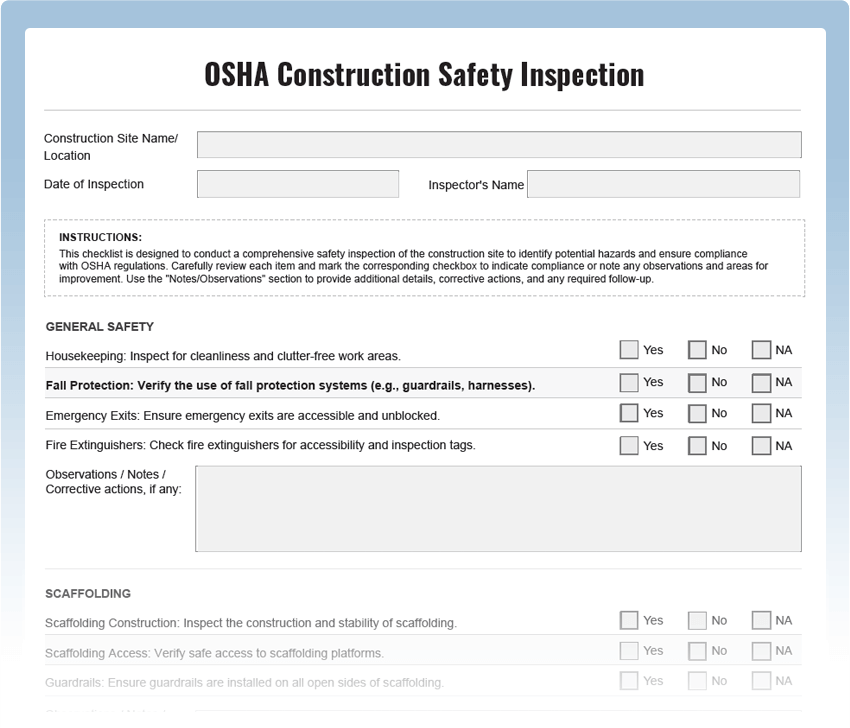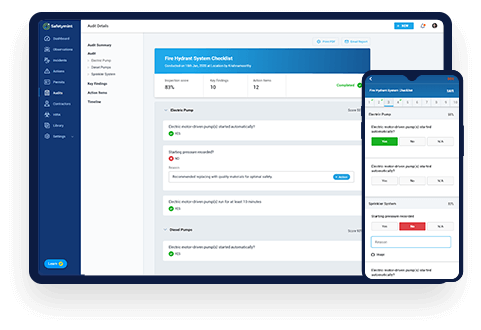OSHA Construction Safety Inspection Checklist
Prioritize the safety of your construction site with our comprehensive OSHA Construction Safety Inspection Checklist. This free PDF template covers all critical aspects of construction safety, empowering you to identify potential hazards, perform regular inspections, and maintain a secure work environment for all construction personnel.
Digitize this Checklist on Safetymint
- Create unlimited, customized checklists
- Add Actions, with automated reminders
- Works seamlessly with or without internet
- Access via web browsers, mobile or tablets

What is an OSHA Construction Safety Inspection Checklist?
An OSHA Construction Safety Inspection Checklist is a systematic tool used to assess the safety conditions on construction sites. It includes a series of checkpoints designed to inspect various aspects of construction safety, such as personal protective equipment (PPE), scaffolding, fall protection, electrical safety, and more. Regular construction safety inspections are essential for preventing accidents, protecting workers, and complying with OSHA regulations.
Key Areas to Inspect for Construction Safety:
- PPE: Check that all workers have appropriate PPE and are using it correctly.
- Scaffolding: Inspect scaffolding for stability, secure assembly, and proper access.
- Fall Protection: Ensure that proper fall protection systems are in place and being used correctly.
- Electrical Safety: Verify that electrical systems are grounded, labeled, and safe.
- Heavy Equipment Safety: Assess the safe operation of heavy machinery and equipment.
- Excavation Safety: Inspect trenches and excavations for proper shoring and sloping.
- Fire Prevention Measures: Check the availability and condition of fire extinguishers and fire prevention equipment.
- Housekeeping: Evaluate the overall site cleanliness and organization to prevent trip hazards.
Common Construction Safety Inspection Findings:
Frequent issues found during construction safety inspections include:
- Missing or Improper PPE: Workers not using or using PPE incorrectly.
- Unsafe Scaffolding: Scaffolding with missing guardrails or unsecured platforms.
- Inadequate Fall Protection: Lack of fall arrest systems or improper use of safety harnesses.
- Electrical Hazards: Unprotected or damaged electrical wires and equipment.
- Lack of Training: Workers not properly trained for specific tasks or equipment operation.
Construction Safety Inspection Best Practices:
- Scheduled Inspections: Conduct routine construction safety inspections at scheduled intervals.
- Pre-Task Planning: Encourage pre-task planning and hazard assessments before starting work.
- Emergency Response Plan: Ensure that workers are aware of the site’s emergency response plan.
- Training and Education: Provide comprehensive safety training for all construction personnel.
- Continuous Improvement: Act on inspection findings to improve safety measures and address hazards.
Also read: Top 10 OSHA inspection checklists




